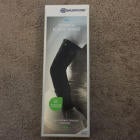Imagine, say, 20 years down the road every single pitcher in the majors wearing an elbow brace that's been proven to help prevent ulnar-collateral ligament tears, meaning a drastic decrease in Tommy John surgeries.
"That might happen," said renowned orthopedic surgeon Dr. James Andrews. "I can't say that it will, but we've got to get enough people interested in using it."
The "it" there would be the Bauerfeind Sports Elbow Brace. Here is Dr. Andrews discussing it, when it was known as the EpiTrain PowerGuard:
As discussed with both Dr. Andrews and Erin Grigsby of Bauerfeind, elbow injuries occur at the very end of the throwing motion. Valgus extension overload. Basically, when the arm is full extending through a pitching motion, the bones that meet at the elbow slam together. This happens every single pitch, so over and over, bones are slamming together violently. This can create a bone spur, loose bodies and injuries to the ligaments.
This elbow brace is designed to prevent that by preventing the arm from going all the way to full extension while still having the feel of a full range of motion -- thus not affecting performance. My biggest question to both Dr. Andrews and Grigsby was regarding performance. If a pitcher feels like he doesn't have command or isn't comfortable, there's no way he'd wear it.
"We did a study to see how they would function in it on some high school and college kids," said Dr. Andrews. "It seemed to not create any significant biomechanical changes."
Of course, as Dr. Andrews noted, this has been in the works for four years.
"It was tested to make sure it did what we said it did, biomedically, and it prevents hyperextension of the elbow," Grigsby said. "That was in healthy players. The problem with studies is they're very expensive and take a long time. And the biggest problem with the major leaguers is they don't like it to be announced who is hurt."
Both noted that the brace can be used by players coming back from injury. It's not necessarily a preventative brace yet, For now, it's mostly being used to combat inflammation, swelling, bone spurs and pain. It can be used post-TJ surgery and can also limit pain and further injury. I mentioned the bone spurs to Mets starters Noah Syndergaard and Steven Matz, and Grigsby believes it would help.
Still, I couldn't help but focus on the dream that it would someday become part of a uniform -- like batters wearing helmets -- and massively lower the number of season-ending injuries. How does it feel?
One player who used it in game competition said "it is able to be worn during competition without affecting performance."
I wanted to try it myself.
Now, I did play in college, but that was almost 20 years ago. Still, I throw with my son regularly and, as noted in the video, it doesn't feel much different. It did not alter my throwing motion at all and did not feel as if it was holding me back in any way. When resting, it felt tighter than usual, obviously, but when throwing I really barely noticed it. Notice above in the YouTube of Dr. Andrews where he discusses the dial. You can tighten it to the point that your arm is bent at, say, a 10-degree angle or you can loosen it to the point where it feels like there is 100 percent full extension available. To each his own on this one.
Again, there have been a few testimonials from players wearing it in competition and not only did some believe it didn't alter performance, several said it felt like it reduced stress on the elbow. Dr. Andrews did say that some pitchers said they don't like wearing it while pitching, though.
"We've never really had a protective elbow brace that anyone could use with a pitching motion," said Dr. Andrews.
The goal here is for both "prevention and protection," he said. They haven't clinically proven it does both yet, but that's in the works.
"It's the best we've got," he said of this brace. "There's nothing else out there."
In the meantime, it doesn't start with pitch counts in Major League Baseball or even college. It starts when the arm is growing and maturing through the youth league years. When I interviewed Dr. Andrews, he had gotten done working with two teenagers with UCL injuries and it's become far too common for his tastes.
"Getting kids to use it is another problem," he said of the brace.
"[Kids] always come back too early. They never wait the length of time you ask them to. Maybe this will give them some protection when they start throwing and help get them fully healed."
In the meantime, dial it back. What causes arm injuries? Overuse.
"Fatigue," Dr. Andrews said. "It's fatigue. Event fatigue, meaning too many pitches in a game. Seasonal fatigue, too many innings in a season. Year-round fatigue, playing year round. You need three or four months off to recover. Even professional pitchers need that time off."
Maybe, just maybe, not running kids' arms into the ground at a young age along with the Bauerfeind Elbow Brace gets us to a place where Tommy John surgery is no longer such a common phrase when discussing Major League Baseball. That would be pretty nice, no?


















